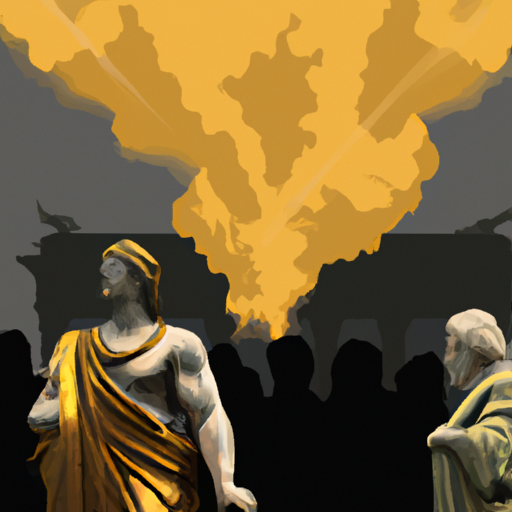A Historical Look at How Poor People Were Viewed in the Victorian Era
Unearth the past, uncovering a glimpse into how poverty was perceived in the days of Victorian England! Delve deep into a time period that has all but been forgotten, to gain insight into the views and opinions of those who lived during this era. Explore the depths of how poverty was viewed and understood by those who lived through it. Uncovering a piece of history that has long since been lost to time.

The Victorian era was a time of immense transformation and upheaval, with industrialization leading to extreme disparities of wealth among the classes. This period in history left a lasting impression on our culture today, particularly in regards to how poverty was perceived. Those living during this era had their own opinions about the issue, which were often shaped by religious beliefs and moral values.
The Victorians viewed poverty as something to be pitied and aided wherever possible. They believed that those suffering from it were usually not responsible for their circumstances, instead being victims of circumstance. To this end, various charitable organizations were established during the Victorian era to provide assistance to those less fortunate than themselves.
At the same time, poverty was also seen as an opportunity for self-improvement and spiritual growth. The Victorians believed that if one worked hard enough they could overcome their plight and rise out of poverty – a notion further reinforced by religious teachings which promised reward in the afterlife for such efforts here on earth.
In conclusion, the Victorians had a multifaceted perspective on poverty which combined sympathy with optimism for those affected by it. By understanding how they viewed poverty during this period we can gain insight into how attitudes towards this issue have changed over time – providing us with valuable lessons from history as well as greater appreciation for our present day society!
.
Introduction

The Victorian era (1837-1901) saw a perplexing array of attitudes towards the poor. Though there was some recognition of their plight, and charitable giving to aid them, a prevailing notion of social class and expectations for those in poverty remained. Poor people were considered inferior and undeserving, with many believing it was inevitable for certain groups to remain in poverty due to laziness or moral failings. This resulted in a tendency to keep the poor out of sight, not allowing them to mingle with more affluent members of society.
– History of Poor Relief in the Victorian Era
A perplexing and tumultuous account of the past, poor relief in the Victorian era is a captivating look into how the British government sought to combat poverty during the 19th century. This system of providing fiscal aid and other forms of support had existed for many years prior to this period, but it was then that it became more formally organised.
The Poor Law Amendment Act of 1834 was a major turning point in the history of poor relief in Britain. This law established a system whereby local parishes were responsible for supplying assistance to their own citizens who were too impoverished to support themselves. These parishes were allowed to impose taxes on their wealthier inhabitants, which would then be used to fund relief for those who needed it most.
Workhouses were also set up across the country, which provided basic accommodation and meals for those who could not work or whose wages were too low. These places, however, were often unpleasant and contained harsh conditions. They also offered employment opportunities for able-bodied persons such as spinning yarn or stitching clothes.
The Victorian era saw an increase in charitable organisations focused on helping the indigent, including soup kitchens and religious charities. These institutions provided much needed assistance to people who would have otherwise been unable to survive without them. Furthermore, they helped reduce public stigma attached with poverty by demonstrating that there are many ways people can help each other out in times of need without relying solely on state intervention.
This history of poor relief in the Victorian era serves as an essential reminder that poverty has been present since antiquity and governments have been striving for solutions throughout this time frame. It also shows us how significant charitable giving is when attempting to alleviate poverty and aiding those most in need – something which remains just as relevant today as it did back then.
– Historical Perspectives on Poverty in the Victorian Age
Amidst the grandeur and opulence of the Victorian Age (1837-1901), a much darker reality lurked beneath – poverty. By delving into historical records, we can gain insight into how poverty was perceived and endured during this era.
At first, poverty was generally regarded as a moral failing or God’s punishment. This outlook was embodied in the Poor Law Amendment Act of 1834, which aimed to discourage people from seeking public aid by introducing draconian workhouse conditions for those who did. Moreover, it was assumed that destitution made people more prone to criminal behaviour due to lack of resources and education.
As time went on, attitudes towards poverty changed from judgemental to compassionate. Charles Dickens’ works such as Oliver Twist and Hard Times drew attention to the struggles of the poor, raising awareness about social injustices. Additionally, welfare reforms were implemented like free school meals for impoverished areas.
The Victorian Age saw considerable transformation in views towards poverty and its origins. While initially viewed as a sign of moral weakness or divine retribution, increasingly people began to recognize it as an issue stemming from systemic inequality and unfairness. As such, it is essential that we remember this history so we can keep striving for a brighter future for those living in poverty today.
– The Social Stigma of Poverty During the Victorian Period
Amid the Victorian age, an era of noteworthy social change, destitution rose as a pressing issue. Be that as it may, rather than being seen as a result of financial and social conditions, poverty was viewed as an ethical shortcoming. This social disgrace connected with destitution had far-reaching outcomes for those living in neediness during this time.
In the Victorian period, those in poverty were thought to be sluggish and careless. It was accepted that if somebody was poor, it was on the grounds that they hadn’t worked sufficiently hard or made shrewd monetary choices. The possibility that neediness was caused by individual disappointments prompted a wide conviction that those in destitution merited their circumstance and ought to be blamed for it.
This disgrace made an atmosphere of humiliation for those living in neediness, which brought about them regularly feeling segregated from society and not having the option to get to assets or help systems to assist them with getting away from their situation. Subsequently, numerous individuals living in destitution during this period were not able to break out of the cycle of need because of the absence of chances accessible to them.
The social disgrace encompassing destitution during the Victorian period implied that those living in neediness were regularly marginalized and avoided from standard society. This further supported the cycle of neediness, as it denied those living in destitution access to training, business openings, and other assets that could have helped them escape their situation.
The social disgrace encompassing destitution during the Victorian period actually remains today. Despite the fact that we currently comprehend more about what causes individuals to live in neediness, there is still a propensity for individuals to see those living in hardship as sluggish or careless instead of casualties of conditions. It is essential that we cooperate to challenge these out-dated convictions and guarantee that everybody approaches assets and open doors paying little mind to their money related status.
– Historical Impact of Industrialization on the Poor in the th Century
The 19th century saw a revolution in production and technology that had far-reaching consequences. While it brought economic growth and development, this prosperity was not shared equally among all classes. The introduction of machines meant the displacement of many jobs, leading to higher unemployment rates and poverty levels. This, combined with rising food prices, made life harder for those at the bottom of society. Furthermore, workers were often subjected to long hours and hazardous conditions without proper safeguards or benefits. These issues only served to exacerbate existing disparities between rich and poor. On the other hand, industrialization also provided some advantages for those on the lower end of the social ladder; access to education was increased, as well as public health services being improved. In conclusion, while industrialization had its drawbacks for some people in the 19th century, it ultimately helped create a more prosperous society overall.
– The Changing Attitudes Towards Poor People in Victorian England
Throughout the ages, perceptions of those in poverty have gone through a radical transformation. During the Victorian period in England, destitution was a noteworthy issue and popular opinion on it shifted drastically. A variety of elements, both economic and social, impacted these sentiments.
The Industrial Revolution brought about an influx of people from countryside to cities looking for work; this caused an explosion of impoverished individuals who had restricted access to necessities and homes, resulting in overcrowding and sickness. Because of this, many viewed poverty as either a moral failing or retribution for wrong-doing. The poor were regarded as indolent and undeserving, prompting prejudice and animosity from those with wealth.
In spite of this, there were also those who empathized with their plight and called for reform. The Poor Law Amendment Act (1834) sought to help those living in need by supplying basic requirements such as food, clothing, and shelter. This law represented a shift in attitude from perceiving poverty as a sin to considering it an unfortunate circumstance that could be remedied through government intervention.
As the 19th century advanced, so did public opinion on poverty. Innovative approaches like Charles Booth’s method for measuring destitution helped shape policies that provided aid while also attempting to decrease its prevalence via education and job openings.
By the end of the Victorian era, views towards poor people had evolved dramatically from one of condemnation to one of sympathy and understanding. This transformation was mainly due to increased awareness regarding poverty’s causes and effects on society along with efforts by reformers who fought for better treatment of those suffering hardship.
conclusion

Throughout the ages, a certain attitude towards poverty has been pervasive in many societies. This outlook cast those who were not able to provide for themselves as morally deficient and undeserving of assistance or compassion. During the Victorian era, this perspective was particularly widespread, with the underprivileged being viewed as indolent and unentitled to any kind of support.
.
Some questions with answers
Q1: How were poor people viewed in the Victorian era?
A1: Poor people in the Victorian era were generally viewed as either lazy or unfortunate, and often faced discrimination and judgement from society.
Q2: What were the attitudes towards poverty?
A2: Attitudes towards poverty in the Victorian era tended to be negative, with many believing that poverty was a result of moral failings or laziness on the part of those affected.
Q3: What kind of help was available for those living in poverty?
A3: During this period, there were a number of charitable organisations which provided assistance to those living in poverty, such as soup kitchens and workhouses.
Q4: How did the government respond to poverty?
A4: The government responded to poverty by passing legislation such as the Poor Law Amendment Act 1834 which aimed to reduce public spending on relief for the poor.
Q5: Was there any social stigma associated with being poor?
A5: Yes, there was a strong social stigma associated with being poor during this period, as it was seen as a sign of moral failing or laziness.




